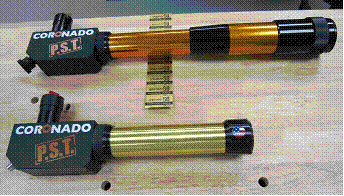Upgrading a PST
Jack Kramer
When my Coronado PST (Personal Solar Telescope) saw first light, a prominence snapped into view. It was awesome! This is a dedicated 40mm solar telescope containing an integral hydrogen alpha filter with a <.5A bandpass. A version of the PST with a narrower bandpass <.5A filter costs almost twice as much as the basic PST but would provide improved contrast.
The PST is a fine little telescope, but eventually a hazy spot appeared on the objective lens when viewed under a bright light and I learned that this was a defect that Coronado would repair under warranty. The haze on some PSTs is a result of degradation of the ITF coating. ("ITF" stands for "Induced Transmission Filter" which uses dielectric layers on each side of the metal layers to provide blocking in the far infra-red.) As the ITF's were received from an outside source, Coronado assembled them into the PST objective. But if too much time elapsed before cementing, the coating began breaking down. This degradation could not be seen during assembly or during field testing prior to shipment. The coating only starts to visibly degrade a few months after assembly. Because this problem does not affect safety - only performance - and does not affect all PSTs, Coronado is repairing the affected units rather than issuing a general recall. Coronado's revised procedure is to use another style of ITF and position it further down in the optical tube. The front objective on these units will look different, having a basically clear or slightly bluish tint.
I was about to send my PST back to Coronado for repair when S&T published a new product blurb about Denkmeier Optical's Spectrum60 upgrade for the PST. This increases the aperture of the PST from a 40mm to a 60mm aperture Ha scope by completely replacing the present PST front tube assembly. The upgrade also includes replacing the original 5mm blocking filter with a 10mm to accommodate the larger image size of the solar disc produced by the 60mm F/10 objective. The upgrade does not change the bandwidth or transmission characteristics of the PST Etalon but does provide a higher resolution image. Denkmeier also adds an upgraded focuser knob. The cost of the Spectrum60 upgrade was $599. And who can argue with better resolution! So I put my name on the list for one of the first 100 units that would become available once Denkmeier had ramped up production of the optical components. The photo here from Denkmeier shows an upgraded scope above an original PST.

Once I received my upgraded PST, it was time to see what it could do. Since I didn't have an original PST to do a side-by-side comparison, my impressions are somewhat anecdotal. The first thing I noticed was the larger field of view - the entire sun was visible with a 12mm Orthoscopic eyepiece whereas part of the sun was cut off with that eyepiece in the original PST. Using a 7mm Ortho, I was able to push the scope to 86x, whereas the original PST gave decent images only up to about 35x. Many prominences were visible along the limb of the sun. The PST has a sweet spot where features are sharpest at certain areas of the field, which sometimes varies from scope to scope. The Spectrum60 also has a sweet spot, but it's larger and centered in the field. Letting a prominence drift across the field of view, I judge that the center 80% of the field maintained a sharp focus. These observations were at mid-day when solar viewing is at its worst due to atmospheric unsteadiness - images in the early morning and evening tend to be sharper.
The instructions note that the solar finder on the PST will only be partially usable after the Spectrum60 upgrade. It stated the solar image will no longer be visible when the scope is pointed directly at the sun due to the 60mm lens and cell blocking some of the field available to the small finder screen. However, I found that the sun remained visibly centered in the finder if the solar image is moved across the field in azimuth, so at least for now I see no need for any other type of finder.
If you already own a standard PST and hanker to see better detail on the sun, then Denkmeier's Spectrum60 upgrade makes a lot of sense.
Published in the October 2010 issue of the NightTimes




